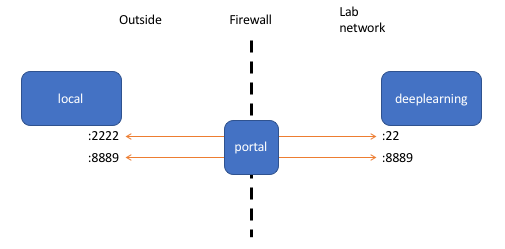Port forwarding onto a single remote server
- ssh into remote server
- run “jupyter notebook –no-browser –port=port-forwarding
- note: the port-forwarding can take on almost any value; 8888 is the commonly used port for jupyter port forwarding
- open a new shell
- run “ssh -L local-port:localhost:port-forwarding username@remove-server”
- note: local-port can take on any value and is the port we use to access localhost jupyter notebook instance. Often, many people use 8000 for jupyter notebook
- note: port-forwarding must match the value we specified in step 2
- That’s it! Open your browser and type localhost:local-port
Port forwarding into a remote server, within another remote server
Why might we do this?
In HPC settings, we may need to access a first remote server that gives us access to compute clusters; we may then ssh into a given cluster, thus creating another remote server from which we need to run jupyter notebook.
How do we do this?
Fortunately, the steps are quite similar to the case with a single remote server:
- ssh into remote server
- run “jupyter notebook –no-browser –port=port-forwarding
- open a new shell
- run “ssh -L local-port:localhost:port-forwarding username@remove-server-1”
- note: pay attention that we are ssh-ing into the outer remote server here (remove-server-1)
- Within that same second shell, run “ssh -L port-forwarding:localhost:port-forwarding username@remove-server-2”
- note: pay attention that we are ssh-ing into the inner remote server here (remove-server-2)
- also note that we use port-forwarding twice, instead of once
- That’s it! Open your browser and type localhost:local-port
